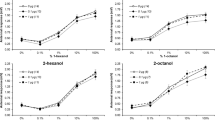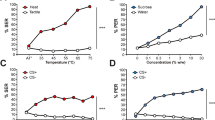Abstract
Free-flying honeybees (Apis mellifera) were trained on tasks in which they had to choose one of three odours for a reward of sugar water. In acquisition, the bees learned this task in about five trials of training. Unrewarded retention tests showed that the odour memory was retained after 24-h delay. These findings are unsurprising. Integration experiments were then performed in which the bees had to learn two successive tasks of odour discrimination with conflicting demands. In task 1 (20 trials), one of three odours provided sugar water while the other two provided tap water. In task 2 (ten trials), which followed task 1 immediately, a different odour provided the reward. The bees were given unrewarded tests immediately after training on task 2 and then tested again after 10 min, 22 h or 24 h. The 22-h delay coincided with the circadian time for the start of task 1 training, while the 24 h coincided with the circadian time for the end of the task 2 training. Bees strongly preferred the rewarded odour for task 2 on immediate testing and after a 10-min delay. After delays of 22 and 24 h, they still preferred the rewarded odour for task 2. We conclude that the most recently acquired odour memory dominates behaviour in honeybees. The close association between floral odour and reward availability under natural circumstances may predispose honeybees to rely more on the most recently rewarded odour cue rather than on circadian time.






Similar content being viewed by others
References
Ackerman JDE, Melendez-Ackerman J, Salguero-Faria J (1997) Variation in pollinator abundance and selection on fragrance phenotypes in an epiphytic orchid. Am J Bot 84:1383–1390
Armstrong JE, Marsh D (1997) Floral herbivory, floral phenology, visitation rate and fruit set in Anaxogerea crasipetala (Annonaceae), a lowland rain forest tree of Costa Rica. J Torrey Bot Soc 124:228–235
Beekman M (2005) How long will honeybees (Apis mellifera) be stimulated by scent revisit past-profitable forage sites? J Comp Physiol A 191:1115–1120
Benard J, Giurfa M (2004) A test of transitive inferences in free-flying honeybees: unsuccessful performance due to memory constraints. Learn Mem 11:328–336
Bogdany FJ (1978) Linking of learning signals in honeybee orientation. Behav Ecol Socibiol 3:323–336
Cheng K (2000) How honeybees find a place: lessons from a simple mind. Anim Learn Behav 28:1–15
Cheng K, Wignall AE (2006) Honeybees (Apis mellifera) holding on to memories: response competition causes retroactive interference effects. Anim Cogn 9:141–150
Cheng K, Shettleworth SJ, Huttenlocher J, Rieser JJ (2007) Bayesian integration of spatial information. Psychol Bull 133:625–637
Chittka L (1998) Sensorimotor learning in bumblebees: long-term retention and reversal training. J Exp Biol 201:515–524
Chittka L, Thomson JD (1997) Sensori-motor learning and its relevance for task specialization in bumble bees. Behav Ecol Sociobiol 41:385–398
Deneve S, Pouget A (2004) Bayesian multisensory and cross-modal spatial links. J Physiol (Paris) 98:249–258
Devenport LD, Devenport JA (1994) Time-dependent averaging of foraging information in least chipmunks and golden-mantled ground squirrels. Anim Behav 47:787–802
Devenport L, Hill T, Wilson M, Ogden E (1997) Tracking and averaging in variable environments: a transition rule. J Exp Psychol Anim Behav Proc 23:450–460
Free JB (1970) The flower constancy of bumble bees. J Anim Ecol 39:395–402
Galen C, Kevan PG (1983) Scent and colour, floral polymorphism and pollination biology in Polemonium viscosum Nutt. Am Midl Nat 104:281–289
Getz WM, Page RE (1991) Chemosensory communication and kin recognition in honey bees. Ethol 87:298–315
Giurfa M (2007) Behavioural and neural analysis of associative learning in the honeybee: a taste from the magic well. J Comp Physiol A 193:801–824
Koltermann R (1971) 24-Std-Periodik in der Langzeiterinnerung an Duft- und Farbsignale bei der Honigbiene [24-hour cycles in the long-term memory of honeybees for scent and colour signals]. Z Vgl Physiol 75:49–68
Kriston I (1973) Die Bewertung von Duft- und Farbsignalen als Orienetierungshilfen an der Futterquelle durch Apis mellifera L [The use of scent and colour signals as orientation cues at the food source in Apis mellifera L]. J Comp Physiol 165:147–154
Kunze J, Gumbert A (2001) The combined effect of color and odor on flower choice behavior of bumble bees in flower mimicry systems. Behav Ecol 12:447–456
Menzel R (1985) Learning in honeybees in an ecological and behavioural context. In: Hölldobler B, Lindauer M (eds) Experimental behavioural ecology. Gustav Fischer, Stuttgart, pp 55–74
Menzel R (1990) Learning, memory and “cognition” in honeybees. In: Kesner RP, Olton DS (eds) Neurobiology of comparative cognition. Lawrence Erlbaum, Hillsdale, NJ, pp 237–292
Menzel R (1999) Memory dynamics in honeybees. J Comp Physiol A 185:323–340
Menzel R (2001) Searching for the memory trace in a mini-brain, of the honeybee. Learn Mem 8:53–62
Menzel R, Shmida A (1993) The ecology of flower colours and the natural colour vision of insect pollinators: the Israeli flora as a study case. Biol Rev 68:81–120
Menzel R, Greggers U, Hammer M (1993) Functional organization of appetitive learning and memory in a generalist pollinator, the honey bee. In: Papaj DR, Lewis AC (eds) Insect learning. Chapman Hall, New York, pp 79–125
Pahl M, Zhu H, Pix W, Tautz J, Zhang S (2007) Circadian timed episodic-like memory—a bee knows what to do when, and also where. J Exp Biol 210:3559–3567
Pellmyr O, Thein LB (1986) Insect reproduction and floral fragrances: keys to the evolution of angiosperms? Taxon 35:76–85
Pham-Delègue MH, Etievant P, Guichard E, Masson C (1989) Sunflower volatile involved in discrimination among genotypes and stages. J Chem Ecol 15:329–343
Pham-Delègue MH, Blight MM, Le Melayer M, Marion-Poll F, Pickette JA, Wadhams LJ, Woodlock CM (1992) Plant chemicals involved in honeybee-rapeseed relationships: behavioural, electrophysiological and chemical studies. In: Menken SBJ, Visser JH, Harrewijn P (eds) Dordrecht Kluwer Proceedings of the Eighth International Symposium on Insect–Plant Relationships. Kluwer, Dordrecht, pp 129–130
Prabhu C, Cheng K (2008) One day is all it takes: circadian modulation of the retrieval of colour memories in honeybees. Behav Ecol Sociobiol doi:10.1007/s00265-008-0631-3
Reinhard J, Srinivasan MV, Zhang SW (2004) Floral scents induce recall of navigational and visual memories in honeybees. J Exp Biol 207:4371–4381
Smith BH, Cobey S (1994) The olfactory memory of the honeybee Apis mellifera. II. Blocking between odorants in binary mixtures. J Exp Biol 195:91–108
Von Frisch K (1967) The dance language and orientation of bees. Belknap, Cambridge, MA
Wahl O (1932) Neue Untersuchungen über das Zeitgedächtnis der Bienen [New investigations on memory for time in bees]. Z Vgl Physiol 18:709–717
Waser NM (1986) Flower constancy: definition, cause and measurement. Am Nat 127:593–603
Winston ML (1987) The biology of the honey bee. Harvard University Press, Cambridge, MA
Zhang SW, Schwarz S, Pahl M, Zhu H, Tautz J (2006) Honeybee memory: a honeybee knows what to do and when. J Exp Biol 209:4420–4428
Acknowledgments
This research was supported by a graduate student research fund from the Centre for the Integrative Study of Animal Behaviour, Macquarie University. CP was supported by a graduate scholarship from Macquarie University. Thanks are due to Mark Peterson for maintaining the beehives. The experiments comply with the current laws of Australia. Portions of the results reported here were presented at the conference of the Australasian Society for the Study of Animal Behaviour at Macquarie University, Sydney, Australia, in 2006 and at the Entomological Society of Australia at Adelaide in 2006.
Author information
Authors and Affiliations
Corresponding author
Additional information
Communicated by M. Giurfa
Rights and permissions
About this article
Cite this article
Prabhu, C., Cheng, K. Recency preference of odour memory retrieval in honeybees. Behav Ecol Sociobiol 63, 23–32 (2008). https://doi.org/10.1007/s00265-008-0632-2
Received:
Revised:
Accepted:
Published:
Issue Date:
DOI: https://doi.org/10.1007/s00265-008-0632-2




